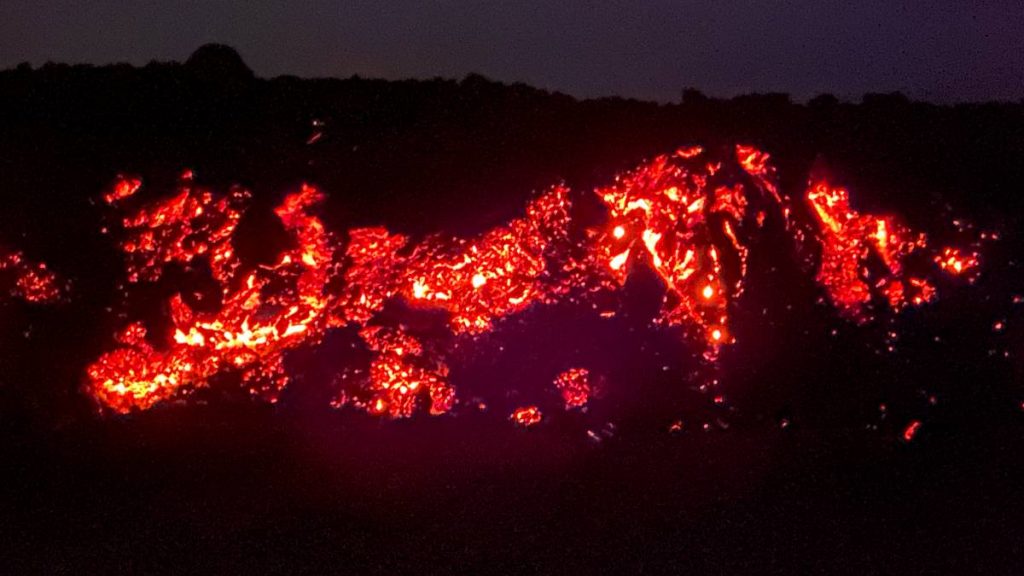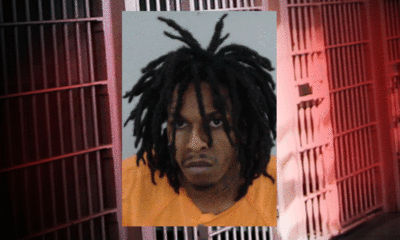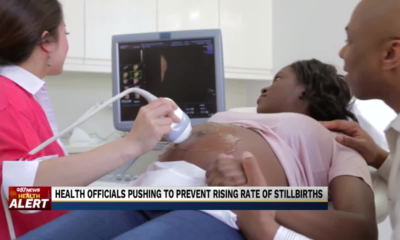The front of Mauna Loa’s lava flow continues to inch closer to Daniel K. Inouye Highway. As of noon, the flow front was 2.15 miles from the thoroughfare.
Fissure 3 is currently the only active fissure. According to Hawaiian Volcano Observatory, there continue to be several small overflows from main channels recorded over the past day. During the past 24 hours, the lava flow advanced at an average rate of about 20 feet per hour. Advance rates may be highly variable over the coming days and weeks.
Though the advance rate has slowed over the past several days, the lava flow remains active with a continuous supply from the fissure 3 vent.
On the flat ground between Mauna Loa and Mauna Kea, lava flows advance more slowly, spread out, and inflate. Individual lobes may advance quickly, and then stall. Additional breakouts may occur if lava channels get blocked upslope. There are many variables at play and both the direction and timing of flow advances are expected to change over periods of hours to days, making it difficult to estimate when or if the flow will impact Daniel K. Inouye Highway.
Sulfur dioxide (SO2) emission rates of approximately 120,000 tonnes per day (t/d) were measured Sunday. These are decreased from the rate of 180,000 t/d measured on Dec. 1, but elevated emissions of this magnitude can still have moderate to severe impacts on regional air quality, depending on plume rise rate and wind direction.
Volcanic gas is rising high and vertically into the atmosphere before being blown to the west at high altitude, generating vog (volcanic air pollution) in areas downwind. The International Volcanic Health Hazard Network has detailed information about vog: https://vog.ivhhn.org/. Forecasts for the dispersion of vog can be found on the Mauna Loa Vog Forecasting Dashboard: https://vog.ivhhn.org/content/mauna-loa-eruption.
Tremor (a signal associated with subsurface fluid movement) continues beneath the currently active fissure. This indicates that magma is still being supplied to the fissure, and activity is likely to continue as long as we see this signal.
There is no active lava within Moku’āweoweo caldera nor the Southwest Rift Zone. Experts do not expect any eruptive activity outside the Northeast Rift Zone.
Original post: The lava from the Mauna Loa eruption continues to spew out of Fissure 3 — and at a larger volume than previously estimated — but the main flow continues to move slowly and behave like “really, really thick pancake batter.”
In the past day the lava flow has progressed less than a tenth of a mile and is now about 2.2 miles from reaching Daniel K. Inouye Highway, according to figures from the Hawaiian Volcano Observatory.
“The lava flow is advancing sideways to the west and east about as fast as it is moving forward,” said Ken Hon, the federal observatory’s Scientist-in-Charge.
The front of the lava flow is about 15 feet thick and moving at about 50 feet per hour. At this rate, the lava would take at least another week to reach the Big Island’s main east-west highway, also known as Saddle Road.
At its current path, the lava flow is headed near the intersection of Old Saddle Road and Daniel K. Inouye Highway,
Scientists continue to say there are still too many variables to determine when the lava will cross the road — or even if it will.
“We still don’t know,” Hon said.
In the meantime, Hawai’i County and other government agencies continue to plan for the possibility of a road closure.
The county also is continuing to work on making the traffic flow along the highway — which is used daily by thousands of residents for work, business and other everyday reasons — as efficient as possible.
The influx or people who have flocked to the area to see the lava flow down the northeast flank of Mauna Loa has remained steady since Mauna Loa erupted a week ago, at about 11:30 p.m. on Nov. 27.
On Sunday morning, the 4.5-mile section of Old Saddle Road on Pōhakuloa Training Area land that had been created days earlier as a lava viewing area had to be shut down for hours following the discovery of unexploded ordnance.
Lt. Col. Kevin Cronin with the U.S. Army Garrison said the item found Sunday was “a training ordnance that produces smoke, so not a bomb that would produce any type of shrapnel or fragments.
“Based on the current flow and based on the conditions of the training areas on Pōhakuloa, weʻre not concerned about UXO [unexploded ordnance]or any other type of toxin to the team working at Pōhakuloa, the 200 civilian teammates, the public community or the broader Hawaiian island community.”
But there likely is more unexploded ordnance in the area because it is an active training area, Lt. Cronin said.
The civilian who found the ordnance, which was in lava off of the road, was trespassing. The public is only allowed to be on the roadway and parking area along the viewing route while on military grounds.
The Mauna Loa Forest Reserve also has been closed to the public since shortly after the volcanic eruption began one week ago. Yet, even after the discovery of unexploded ordnance on Sunday, many people continued to trespass into the closed area.
On Sunday, officers from the state Division of Conservation and Resources Enforcement warned a dozen people to stay out of the active lava zone.
During a media tour, Hawai’i Island Branch Chief Lawrence Terlep Jr. spotted a trio of people walking down Mauna Loa Access Road, which is closed. They told Terlep they thought “the road was only closed to cars.”


 Sports1 year ago
Sports1 year ago
 News2 years ago
News2 years ago
 News2 years ago
News2 years ago
 Entertainment1 year ago
Entertainment1 year ago
 Florida2 years ago
Florida2 years ago
 Entertainment2 years ago
Entertainment2 years ago
 Tech2 years ago
Tech2 years ago
 Business2 years ago
Business2 years ago


